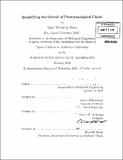Quantifying the stimuli of photorheological fluids
Author(s)
Bates, Sarah Woodring
DownloadFull printable version (10.21Mb)
Other Contributors
Massachusetts Institute of Technology. Dept. of Mechanical Engineering.
Advisor
Anette (Peko) Hosoi and Gareth H. McKinley.
Terms of use
Metadata
Show full item recordAbstract
We develop a model to predict the dynamics of photorheological fluids and, more generally, photoresponsive fluids for monochromatic and polychromatic light sources. Derived from first principles, the model relates the irradiance of light source to the evolution of the concentration of a photoactive species within a sample. We show that the limiting time scale of the dynamics is the rate of photon delivery from the light source. Therefore, we recommend reporting the spectral irradiance of the light source and molar absorptivity, volume, area of the sample exposed to the beam, and concentration of the photoactive species as a standard minimum set of variables. Using the nondimensionalized time suggested by the model, we compare reaction rates of vastly different materials irradiated by very different light sources. We validate our model using both published data from literature and our own rheological experiments. These datasets are shown to collapse onto characteristic curves when properly scaled. We extend the model to fluids with multiple photoactive components, so that we may study fluids that have a reversible transition between states accessible by changing the relative spectral irradiance during operation. We show that considering a light source as polychromatic is critical to determining the photostationary mole fraction as well as scaling results between different light sources. We then use these metrics to determine whether photorheological fluids are appropriate for application onboard a small autonomous robot. We determine that the two candidate photoresponsive fluids, a micellar fluid and a nanoparticle-based fluid, are not appropriate for use in combination with commercial UV LEDs if the speed of transition is a constraint. However, we suggest features of a fluid ideal for this application and illustrate how techniques such as decreasing film thickness are effective in accelerating the reaction only for fluids with high initial absorbances. Finally, we suggest how the model aids research into microstructural dynamics of complex fluids.
Description
Thesis (S.M.)--Massachusetts Institute of Technology, Dept. of Mechanical Engineering, 2010. Cataloged from PDF version of thesis. Includes bibliographical references (p. 125-130).
Date issued
2010Department
Massachusetts Institute of Technology. Department of Mechanical EngineeringPublisher
Massachusetts Institute of Technology
Keywords
Mechanical Engineering.